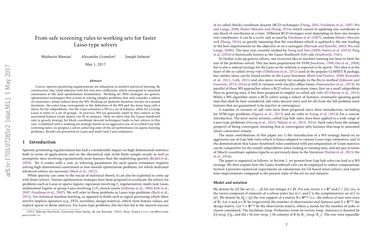From safe screening rules to working sets for faster Lasso-type solvers
Convex sparsity-promoting regularizations are ubiquitous in modern statistical learning. By construction, they yield solutions with few non-zero coefficients, which correspond to saturated constraints in the dual optimization formulation. Working set (WS) strategies are generic optimization techniques that consist in solving simpler problems that only consider a subset of constraints, whose indices form the WS. Working set methods therefore involve two nested iterations: the outer loop corresponds to the definition of the WS and the inner loop calls a solver for the subproblems. For the Lasso estimator a WS is a set of features, while for a Group Lasso it refers to a set of groups. In practice, WS are generally small in this context so the associated feature Gram matrix can fit in memory. Here we show that the Gauss-Southwell rule (a greedy strategy for block coordinate descent techniques) leads to fast solvers in this case. Combined with a working set strategy based on an aggressive use of so-called Gap Safe screening rules, we propose a solver achieving state-of-the-art performance on sparse learning problems. Results are presented on Lasso and multi-task Lasso estimators.
PDF Abstract
